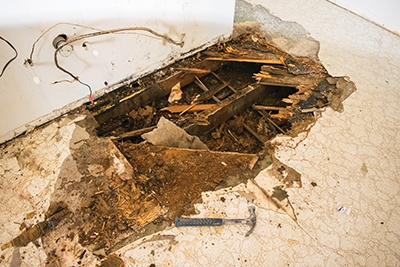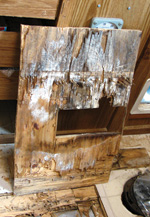If the get rot works then leveling the bad area with fiber reinforced polyester filler will give you a good solid sub floor again.
Alternative to replacing rotted camper floor.
The photos above show where we removed the original rotted out 1 x 1 yes 1 x 1 framing from that rear of the trailer to halfway under the door frame.
This is what you are also supposed to do.
We found that grabbing the staple close to the joist with diagonal pliers and then twisting the pliers on the joist gave enough leverage to yank the long legged staples out of the wood.
Laminate planks fit together in a tongue and groove formation and they are usually not attached to the subfloor with adhesive or nails.
These along with other spacers will be alternated with foam board to minimize weight and maximize insulation.
You can buy epoxy resins that are specifically designed for fixing rotted wood flooring.
This will also keep pipe and wood temperatures stable to prevent further water damage.
We bought it used and knew it would need a lot of work.
A shop vac will quickly suck up the dust and plywood fragments keeping your work area clean and making it much easier to work.
Use a crowbar to remove existing plank flooring.
From the beginning we knew it had rot in the floors that the previous owners had repaired.
Outlining the entry section of the truck camper s floor where the rounded corners add support and structure to the rounded aluminum walls.
This will not work on particle board.
Replace rotten camper floor.
Probe extent of damage and trace out boundary cut out badly damaged areas dry out remaining wood framing.
Use epoxy to repair your rv flooring once everything is nice and dry you are supposed to use epoxy to seal the subfloor wood and make it waterproof.
The second photo is of the new bamboo floori.
Lay fiberglass insulation pads between the floor beams to provide a better heat seal within the rv.
They are generally used for boat repairs where wood is constantly exposed to moisture.
Professionals frequently use epoxy resin combined with a hardener to seal the subfloor surfaces and strengthen the remaining but exposed parts of the floor.
Mark on the plywood where the floor beams below it will lie.
If you are not using this type of epoxy you will need a thinning agent hardener and the standard epoxy resin.
This would be a viable alternative to tear out and put back if only one or two layers of the plywood plys are affected by the water damage.
We had to remove up to the next joist after the wood became solid so that we could have something to screw the new subfloor into.
But you probably won t need it for a camper.
As you pry up the planks they should easily snap free of each other.
























